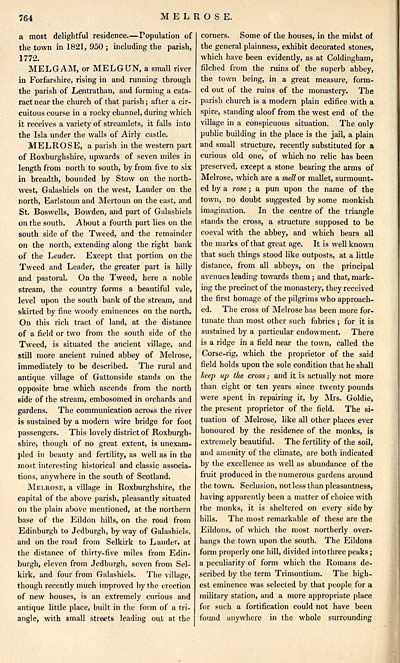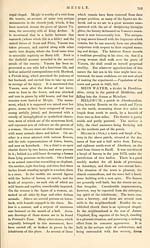Gazetteer of Scotland > Volume 2
(280) Page 764
Download files
Complete book:
Individual page:
Thumbnail gallery: Grid view | List view

764
MELROSE.
a most delightful residence. — Population of
the town in 1821, 950 ; including the parish,
1772.
MELGAM, or MELGUN, a small river
in Forfarshire, rising in and running through
the parish of Lentrathan, and forming a cata-
ract near the church of that parish ; after a cir-
cuitous course in a rocky channel, during which
it receives a variety of streamlets, it falls into
the Isla under the walls of Airly castle.
MELROSE, a parish in the western part
of Roxburghshire, upwards of seven miles in
length from north to south, by from five to six
in breadth, bounded by Stow on the north-
west, Galashiels on the west, Lauder on the
north, Earlstoun and Mertoun on the east, and
St. Boswells, Bowden, and part of Galashiels
on the south. About a fourth part lies on the
south side of the Tweed, and the remainder
on the north, extending along the right bank
of the Leader. Except that portion on the
Tweed and Leader, the greater part is hilly
and pastoral. On the Tweed, here a noble
stream, the country forms a beautiful vale,
level upon the south bank of the stream, and
skirted by fine woody eminences on the north.
On this rich tract of land, at the distance
of a field or two from the south side of the
Tweed, is situated the ancient village, and
still more ancient ruined abbey of Melrose,
immediately to be described. The rural and
antique village of Gattonside stands on the
opposite brae which ascends from the north
side of the stream, embosomed in orchards and
gardens. The communication across the river
is sustained by a modern wire bridge for foot
passengers. This lovely district of Roxburgh-
shire, though of no great extent, is unexam-
pled in beauty and fertility, as well as in the
most interesting historical and classic associa-
tions, anywhere in the south of Scotland.
Melrose, a village in Roxburghshire, the
capital of the above parish, pleasantly situated
on the plain above mentioned, at the northern
base of the Eildon hills, on the road from
Edinburgh to Jedburgh, by way of Galashiels,
and on the road from Selkirk to Lauder, at
the distance of thirty-five miles from Edin-
burgh, eleven from Jedburgh, seven from Sel-
kirk, and four from Galashiels. The village,
though recently much improved by the erection
of new houses, is an extremely curious and
antique little place, built in the form of a tri-
angle, with small streets leading out at the
corners. Some of the houses, in the midst of
the general plainness, exhibit decorated stones,
which have been evidently, as at Coldingham,
filched from the ruins of the superb abbey,
the town being, in a great measure, form-
ed out of the ruins of the monastery. The
parish church is a modern plain edifice with a
spire, standing aloof from the west end of the
village in a conspicuous situation. The only
public building in the place is the jail, a plain
and small structure, recently substituted for a
curious old one, of which no relic has been
preserved, except a stone bearing the arms of
Melrose, which are a meU or mallet, surmount-
ed by a rose ; a pun upon the name of the
town, no doubt suggested by some monkish
imagination. In the centre of the triangle
stands the cross, a structure supposed to be
coeval with the abbey, and which bears all
the marks of that great age. It is well known
that such things stood like outposts, at a little
distance, from all abbeys, on the principal
avenues leading towards them ; and that, mark-
ing the precinct of the monastery, they received
the first homage of the pilgrims who approach-
ed. The cross of Melrose has been more for-
tunate than most other such fabrics ; for it is
sustained by a particular endowment. There
is a ridge in a field near the town, called the
Corse-rig, which the proprietor of the said
field holds upon the sole condition that he shall
keep up the cross ; and it is actually not more
than eight or ten years since twenty pounds
were spent in repairing it, by Mrs. Goldie,
the present proprietor of the field. The si-
tuation of Melrose, like all other places ever
honoured by the residence of the monks, is
extremely beautiful. The fertility of the soil,
and amenity of the climate, are both indicated
by the excellence as well as abundance of the
fruit produced in the numerous gardens around
the town. Seclusion, not less than pleasantness,
having apparently been a matter of choice with
the monks, it is sheltered on every side by
hills. The most remarkable of these are the
Eildons, of which the most northerly over-
hangs the town upon the south. The Eildons
form properly one hill, divided into three peaks ;
a peculiarity of form which the Romans de-
scribed by the term Trimontium. The high-
est eminence was selected by that people for a
military station, and a more appropriate place
for such a fortification could not have been
found anywhere in the whole surrounding
MELROSE.
a most delightful residence. — Population of
the town in 1821, 950 ; including the parish,
1772.
MELGAM, or MELGUN, a small river
in Forfarshire, rising in and running through
the parish of Lentrathan, and forming a cata-
ract near the church of that parish ; after a cir-
cuitous course in a rocky channel, during which
it receives a variety of streamlets, it falls into
the Isla under the walls of Airly castle.
MELROSE, a parish in the western part
of Roxburghshire, upwards of seven miles in
length from north to south, by from five to six
in breadth, bounded by Stow on the north-
west, Galashiels on the west, Lauder on the
north, Earlstoun and Mertoun on the east, and
St. Boswells, Bowden, and part of Galashiels
on the south. About a fourth part lies on the
south side of the Tweed, and the remainder
on the north, extending along the right bank
of the Leader. Except that portion on the
Tweed and Leader, the greater part is hilly
and pastoral. On the Tweed, here a noble
stream, the country forms a beautiful vale,
level upon the south bank of the stream, and
skirted by fine woody eminences on the north.
On this rich tract of land, at the distance
of a field or two from the south side of the
Tweed, is situated the ancient village, and
still more ancient ruined abbey of Melrose,
immediately to be described. The rural and
antique village of Gattonside stands on the
opposite brae which ascends from the north
side of the stream, embosomed in orchards and
gardens. The communication across the river
is sustained by a modern wire bridge for foot
passengers. This lovely district of Roxburgh-
shire, though of no great extent, is unexam-
pled in beauty and fertility, as well as in the
most interesting historical and classic associa-
tions, anywhere in the south of Scotland.
Melrose, a village in Roxburghshire, the
capital of the above parish, pleasantly situated
on the plain above mentioned, at the northern
base of the Eildon hills, on the road from
Edinburgh to Jedburgh, by way of Galashiels,
and on the road from Selkirk to Lauder, at
the distance of thirty-five miles from Edin-
burgh, eleven from Jedburgh, seven from Sel-
kirk, and four from Galashiels. The village,
though recently much improved by the erection
of new houses, is an extremely curious and
antique little place, built in the form of a tri-
angle, with small streets leading out at the
corners. Some of the houses, in the midst of
the general plainness, exhibit decorated stones,
which have been evidently, as at Coldingham,
filched from the ruins of the superb abbey,
the town being, in a great measure, form-
ed out of the ruins of the monastery. The
parish church is a modern plain edifice with a
spire, standing aloof from the west end of the
village in a conspicuous situation. The only
public building in the place is the jail, a plain
and small structure, recently substituted for a
curious old one, of which no relic has been
preserved, except a stone bearing the arms of
Melrose, which are a meU or mallet, surmount-
ed by a rose ; a pun upon the name of the
town, no doubt suggested by some monkish
imagination. In the centre of the triangle
stands the cross, a structure supposed to be
coeval with the abbey, and which bears all
the marks of that great age. It is well known
that such things stood like outposts, at a little
distance, from all abbeys, on the principal
avenues leading towards them ; and that, mark-
ing the precinct of the monastery, they received
the first homage of the pilgrims who approach-
ed. The cross of Melrose has been more for-
tunate than most other such fabrics ; for it is
sustained by a particular endowment. There
is a ridge in a field near the town, called the
Corse-rig, which the proprietor of the said
field holds upon the sole condition that he shall
keep up the cross ; and it is actually not more
than eight or ten years since twenty pounds
were spent in repairing it, by Mrs. Goldie,
the present proprietor of the field. The si-
tuation of Melrose, like all other places ever
honoured by the residence of the monks, is
extremely beautiful. The fertility of the soil,
and amenity of the climate, are both indicated
by the excellence as well as abundance of the
fruit produced in the numerous gardens around
the town. Seclusion, not less than pleasantness,
having apparently been a matter of choice with
the monks, it is sheltered on every side by
hills. The most remarkable of these are the
Eildons, of which the most northerly over-
hangs the town upon the south. The Eildons
form properly one hill, divided into three peaks ;
a peculiarity of form which the Romans de-
scribed by the term Trimontium. The high-
est eminence was selected by that people for a
military station, and a more appropriate place
for such a fortification could not have been
found anywhere in the whole surrounding
Set display mode to: Large image | Transcription
Images and transcriptions on this page, including medium image downloads, may be used under the Creative Commons Attribution 4.0 International Licence unless otherwise stated. ![]()
| Gazetteers of Scotland, 1803-1901 > Gazetteer of Scotland > Volume 2 > (280) Page 764 |
|---|
| Permanent URL | https://digital.nls.uk/97434182 |
|---|
| Description | Volume II: Glenbanchor to Zetland. |
|---|---|
| Attribution and copyright: |
|
| Description | By Robert Chambers and William Chambers. Glasgow: Blackie & Son, 1838. 2 volumes. |
|---|---|
| Shelfmark | NF.1461.g.7 |
| Additional NLS resources: | |

